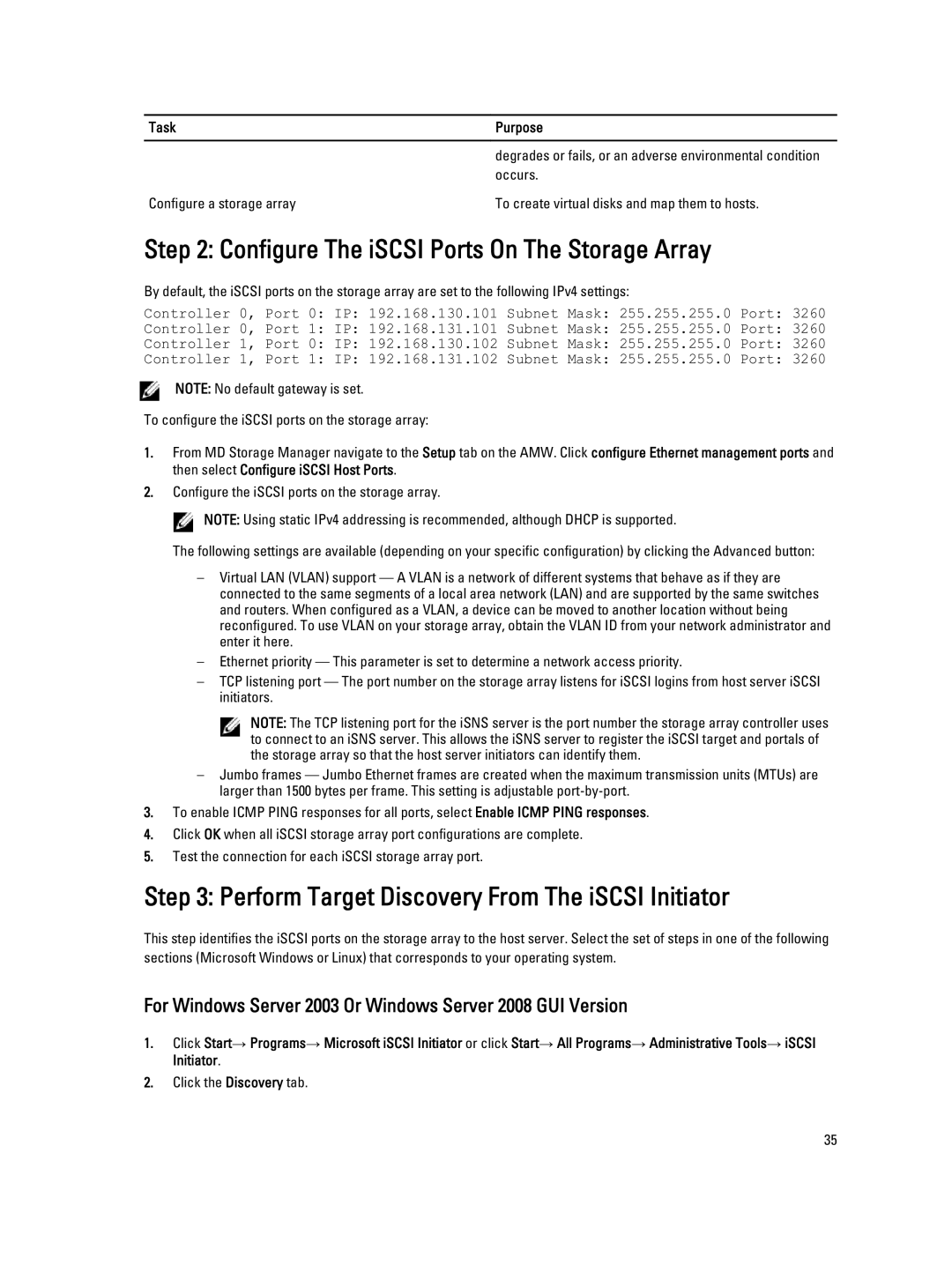
Task | Purpose |
|
|
| degrades or fails, or an adverse environmental condition |
| occurs. |
Configure a storage array | To create virtual disks and map them to hosts. |
Step 2: Configure The iSCSI Ports On The Storage Array
By default, the iSCSI ports on the storage array are set to the following IPv4 settings:
Controller 0, Port 0: IP: 192.168.130.101 Subnet Mask: 255.255.255.0 Port: 3260
Controller 0, Port 1: IP: 192.168.131.101 Subnet Mask: 255.255.255.0 Port: 3260
Controller 1, Port 0: IP: 192.168.130.102 Subnet Mask: 255.255.255.0 Port: 3260
Controller 1, Port 1: IP: 192.168.131.102 Subnet Mask: 255.255.255.0 Port: 3260
NOTE: No default gateway is set.
To configure the iSCSI ports on the storage array:
1.From MD Storage Manager navigate to the Setup tab on the AMW. Click configure Ethernet management ports and then select Configure iSCSI Host Ports.
2.Configure the iSCSI ports on the storage array.
![]() NOTE: Using static IPv4 addressing is recommended, although DHCP is supported.
NOTE: Using static IPv4 addressing is recommended, although DHCP is supported.
The following settings are available (depending on your specific configuration) by clicking the Advanced button:
–Virtual LAN (VLAN) support — A VLAN is a network of different systems that behave as if they are connected to the same segments of a local area network (LAN) and are supported by the same switches and routers. When configured as a VLAN, a device can be moved to another location without being reconfigured. To use VLAN on your storage array, obtain the VLAN ID from your network administrator and enter it here.
–Ethernet priority — This parameter is set to determine a network access priority.
–TCP listening port — The port number on the storage array listens for iSCSI logins from host server iSCSI initiators.
NOTE: The TCP listening port for the iSNS server is the port number the storage array controller uses to connect to an iSNS server. This allows the iSNS server to register the iSCSI target and portals of the storage array so that the host server initiators can identify them.
–Jumbo frames — Jumbo Ethernet frames are created when the maximum transmission units (MTUs) are larger than 1500 bytes per frame. This setting is adjustable
3.To enable ICMP PING responses for all ports, select Enable ICMP PING responses.
4.Click OK when all iSCSI storage array port configurations are complete.
5.Test the connection for each iSCSI storage array port.
Step 3: Perform Target Discovery From The iSCSI Initiator
This step identifies the iSCSI ports on the storage array to the host server. Select the set of steps in one of the following sections (Microsoft Windows or Linux) that corresponds to your operating system.
For Windows Server 2003 Or Windows Server 2008 GUI Version
1.Click Start→ Programs→ Microsoft iSCSI Initiator or click Start→ All Programs→ Administrative Tools→ iSCSI Initiator.
2.Click the Discovery tab.
35
